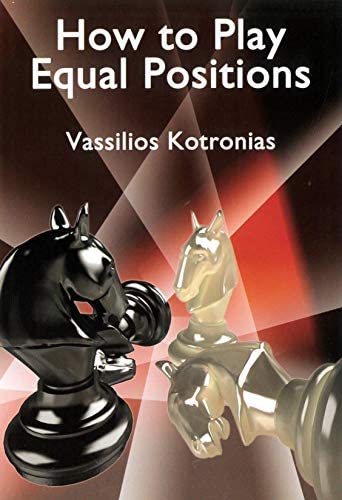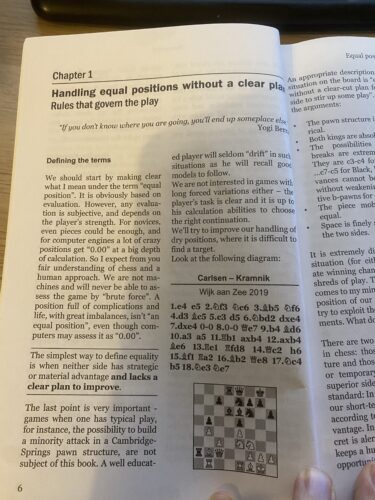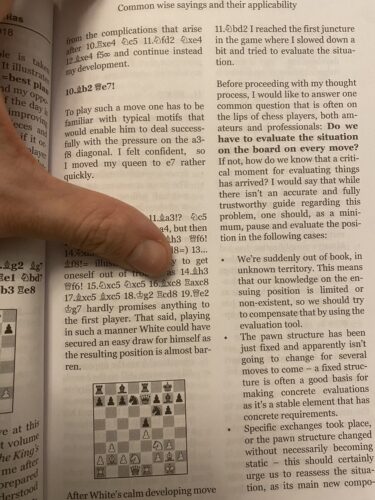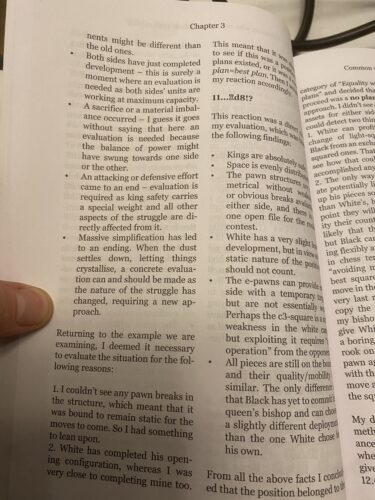Disclaimer 1: The following article contains several affiliate links to Amazon.com, meaning that if you go to Amazon and buy the recommended product (or some other product in an allotted period of time), the author of these lines will get a commission % from the purchase
Disclaimer 2: The following article is an excerpt from my article titled Best Chess Books 2022 in which I reviewed 20 chess books
Vassilios Kotronias: How To Play Equal Positions
What is the book about?
As the title suggests, the book How To Play Equal Positions, written by the Greek Grandmaster Vassilios Kotronias and published by the publishing company Chess Stars 1 is devoted to the topic of playing equal positions. Over the course of six chapters and 200 pages, the author discusses several sub-topics related to the main topic, such as:
- How to handle the positions where there is no clear plan available
- When to bail on and when to play on
- Fear of exchanges in equal or close-to-equal positions
- The dangers of overpressing
To put it simply – the book is aimed at helping the reader handle situations where the computer would give the eternal „0.0“ evaluation, yet where there is a lot more chess to be played. 2
Why do I love this book?
Even though it was published back in 2020, I somehow became aware of the existence of this book somewhere in 2022. Given that earlier that year I crossed 2200 for the first time, the title of the book interested me very much as I realized I am forced to play an equal position with increasing frequency. 3 Thus, even though I wasn’t particularly familiar with Kotronias as an author, I decided to buy the book. And boy, oh, boy – it turned out to be one of the best purchases I have ever made in my entire life.
There is one and only one reason why – text. This book features some of the most thorough, informative, and detailed annotations I have ever seen in the chess book. The author goes to unprecedented lengths to explain the concepts and to shed light on the players’ thinking process during the games. Not only is virtually every single move of every single game followed up with a wall of text, but the author also writes A LOT in between games, summarizing the lessons that were covered in the previous game or introducing new concepts that will be examined in the next game/set of games.
This tendency is apparent from the very beginning of the book. One quick look at pages 6 and 7 of the book will serve as the best evidence:
To be completely honest, I would be full of praise for any chess book with such a heavy focus on textual explanations. But the fact that this one is devoted to such a very complex and convoluted topic makes it extremely good and useful.
It is not only about the quantity of the text, though, but also about the quality. How To Play Equal Positions features some of the most insightful, clear, and compelling explanations of important chess concepts I have ever seen in a chess book. Throughout the book, the author touches on a number of chess-related topics such as playing on a move-by-move basis, pressuring your opponent, posing practical problems, using psychology as a weapon, playing with or without a plan, etc – and explains them in an absolutely masterful way. I remember I was particularly impressed with his thoughts on how and when to evaluate certain positions:
Since many of these concepts are highly useful in all sorts of positions, not just equal positions, I genuinely think this book helps you improve your overall chess skills and thinking process and not just equal positions. And even if it is maybe not the most suitable for absolute beginners and lower-rated players who struggle with tactical issues, I think it is a must-read for any ambitious club player who wants to seriously improve his positional skill, thinking process, and general chess understanding.
Because to my mind, it is one of the most remarkable chess books ever written and I can only wholeheartedly recommend it!
- The company that published the series of books Openings according to Anand and Openings according to Kramnik, among others
- Positions that are encountered increasingly often at all levels, given the level of preparation nowadays
- WHICH HAS EVERYTHING TO DO WITH THE LEVEL OF OPPOSITION AND NOT WITH MY SHITTY OPENING REPERTOIRE, YOU TURD





